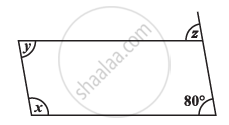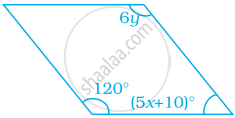Advertisements
Advertisements
Question
Consider the given parallelograms. Find the values of the unknowns x, y, z.

Solution
Since x + 80° = 180° ...[Sum of adjacent angles is 180°]
x = 180° − 80° = 100°
Also 80° = y ...[∵ Opposite angles are equal in a parallelogram]
And x = 180° − z ⇒ 100° = 180° − z
⇒ z = 180° − 100° = 80°
Thus x = 100°, y = 80° and z = 80°
APPEARS IN
RELATED QUESTIONS
The measures of two adjacent angles of a parallelogram are in the ratio 3 : 2. Find the measure of each of the angles of the parallelogram.
Construct a parallelogram ABCD such that l(BC) = 7 cm, m∠ABC = 40° , l(AB) = 3 cm.
ABCD is a parallelogram. What kind of quadrilateral is it if: AC is perpendicular to BD but is not equal to it?
ABCD is a parallelogram. What kind of quadrilateral is it if: AC = BD but AC is not perpendicular to BD?
If a triangle and a parallelogram lie on the same base and between the same parallels, then prove that the area of the triangle is equal to half of the area of parallelogram
The angle between the two altitudes of a parallelogram through the same vertex of an obtuse angle of the parallelogram is 30°. The measure of the obtuse angle is ______.
Find the values of x and y in the following parallelogram.

Two angles of a quadrilateral are each of measure 75° and the other two angles are equal. What is the measure of these two angles? Name the possible figures so formed.
Construct a parallelogram ABCD in which AB = 4 cm, BC = 5 cm and ∠B = 60°.
The following figure RUNS is parallelogram. Find x and y. (Lengths are in cm)

